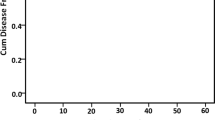Abstract
Male breast cancer is a rare tumour in all parts of the world. About 1% of all breast cancers occur in men. Occurrence of male breast cancer peaks at age 71 years. Familial cases usually have BRCA2 rather than BRCA1 mutations. Presentation is usually a lump or nipple inversion, but is often late, with more than 40% of individuals having stage III or IV disease. We retrospectively reviewed 25 male patients with breast cancer who came to the HCG Cancer Centre, Ahmedabad between 2014 and 2018, and their demographic details, tumor profile, and radiological, histopathological as well as luminal profile findings were studied. The average age at presentation and detection of male breast cancer was 61.08 years. Incidence of male ca. breast over these 4 years was 4.75/year which had a significant increase compared with our own data in the last 8 years (3/year). Male to female ratio for ca. breast was 1:61. One out of 25 (4%) patients had gynaecomastia. The most common histology was invasive ductal carcinoma-not otherwise specified with none of the patients having lobular carcinoma. Majority of patients were ER/PR positive and HER-2 negative. Male breast cancer is having a rising incidence, which in our study is 1.56%. Males have relatively older age at presentation and stage-by-stage treatment remains the same. Males are more likely to be having prognostically favourable luminal subtypes. Male breast cancer in Indian population is currently experiencing an increasing trend. Improved awareness amongst patients and high index of suspicion by the clinicians along with accurate diagnostic techniques help detect the disease at an earlier stage culminating into prolonged overall and disease-free survival.





Similar content being viewed by others
References
Epidemiology of male breast cancer. A meta-analysis of published case-control studies and discussion of selected aetiological factors
Ding YC, Steele L, Kuan CJ et al (2011) Mutations in BRCA2 and PALB2 in male breast cancer cases from the United States. Breast Cancer Res Treat 126(3):771–778 [PUBMED Abstract]
Silvestri V, Rizzolo P, Zanna I et al (2010) PALB2 mutations in male breast cancer: a population-based study in Central Italy. Breast Cancer Res Treat 122(1):299–301 [PUBMED Abstract]
Boyd J, Rhei E, Federici MG et al (1999) Male breast cancer in the hereditary nonpolyposis colorectal cancer syndrome. Breast Cancer Res Treat 53(1):87–91 [PUBMED Abstract]
Fentiman IS, Fourquet A, Hortobagyi GN (2006) Male breast cancer. Lancet 367:595–604
Sasco AJ, Lowenfels AB, Pasker de Jong P (1993) Epidemiology of male breast cancer: a meta-analysis of published case-control studies and discussion of selected aetiological factors. Int J Cancer 53:539–49. https://doi.org/10.1002/ijc.2910530403
Chikaraddi SB, Krishnappa R, Deshmane V (2012) Male breast cancer in Indian patients: is it the same? Indian J Cancer 49(3):272–276
Rai B, Ghoshal S, Sharma SC (2005) Breast Cancer in males: a pgimer experience. J Cancer Res Ther 1(1):31–33
Shah P, Robbani I, Shah O (2009) Clinicopathological study of male breast carcinoma: 24 years of experience. Ann Saudi med 29(4):288–2938
Miao H, Verkooijen HM, Chia KS, Bouchardy C, Pukkala E, Laronningen S et al (2011) Incidence and outcome of male breast cancer: an international population-based study. J Clin Oncol 29(33):4381–4386
Joshi MG, Lee AK, Loda M, Camus MG, Pedersen C, Heatley GJ, Hughes KS (1996) Male breast carcinoma: an evaluation of prognostic factors contributing to a poorer outcome. Cancer 77(3):490–498
McLachlan SA, Erlichman C, Liu FF, Miller N, Pintilie M (1996) Male breast cancer: an 11 year review of 66 patients. Breast Cancer Res Treat 40(3):225–230
Anderson WF, Jatoi I, Tse J, Rosenberg PS (2010) Male breast cancer: a population-based comparison with female breast cancer. J Clin Oncol 28(2):232–239
Author information
Authors and Affiliations
Corresponding author
Additional information
Publisher’s Note
Springer Nature remains neutral with regard to jurisdictional claims in published maps and institutional affiliations.
Rights and permissions
About this article
Cite this article
Shah, T., Shah, N., Vijay, D.G. et al. Male Breast Cancer: Current Trends—a Tertiary Care Centre Experience. Indian J Surg Oncol 11, 7–11 (2020). https://doi.org/10.1007/s13193-019-01021-5
Received:
Accepted:
Published:
Issue Date:
DOI: https://doi.org/10.1007/s13193-019-01021-5



